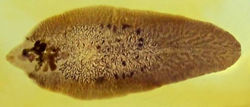Difference between revisions of "Anthelmintic Drugs"
m (capabel = capable) |
|||
| (11 intermediate revisions by 3 users not shown) | |||
| Line 1: | Line 1: | ||
| − | {{ | + | {{unfinished}} |
{{toplink | {{toplink | ||
|linkpage =WikiDrugs | |linkpage =WikiDrugs | ||
| Line 12: | Line 12: | ||
These chemotherapeutic agents are selectively toxic pharmaceutical compounds that aid in parasite control without damage to the host. They are selectively toxic as they have greater affinity to the parasite target site than a similar site in the host. The drugs here are all used for activity against the different classes of helminths but some also have activity against ectoparasites and are known as '''endectocides'''. | These chemotherapeutic agents are selectively toxic pharmaceutical compounds that aid in parasite control without damage to the host. They are selectively toxic as they have greater affinity to the parasite target site than a similar site in the host. The drugs here are all used for activity against the different classes of helminths but some also have activity against ectoparasites and are known as '''endectocides'''. | ||
| − | These drugs as usually formulated so that they can be administered orally (in drench, tablet or in feed form), by injection or percutaneously (as a pour on). In cattle production intraruminal delivary systems or '''rumen boluses''' have been developed. They are | + | These drugs as usually formulated so that they can be administered orally (in drench, tablet or in feed form), by injection or percutaneously (as a pour on). In cattle production intraruminal delivary systems or '''rumen boluses''' have been developed. They are capabel of delivering the anthelmintic for periods of over 90 days. There are two types of delivery system. The '''sustained release''' boluses work via a diffusion gradient, osmotic pump or mechanical device and emit the anthelmintic at a constant rate. The '''pulse release''' boluses emit therapeutic doses every three weeks. Oxfenbendazole is currently the only drug that has been formulated in this way. |
| − | On the following pages we shall discuss all the main classes of anthelmintics that are on the market, how they work and which classes of parasites they are active against | + | On the following pages we shall discuss all the main classes of anthelmintics that are on the market, how they work and which classes of parasites they are active against. |
| − | + | * [[Levamisole and Morantel]] | |
| − | * [[Levamisole | ||
| − | |||
| − | |||
| − | |||
| − | |||
| − | |||
| − | |||
| − | |||
| − | |||
| − | |||
| − | |||
| − | |||
| − | |||
| − | |||
| − | |||
| − | |||
Revision as of 11:00, 3 November 2008
| This article is still under construction. |
|
|
These chemotherapeutic agents are selectively toxic pharmaceutical compounds that aid in parasite control without damage to the host. They are selectively toxic as they have greater affinity to the parasite target site than a similar site in the host. The drugs here are all used for activity against the different classes of helminths but some also have activity against ectoparasites and are known as endectocides.
These drugs as usually formulated so that they can be administered orally (in drench, tablet or in feed form), by injection or percutaneously (as a pour on). In cattle production intraruminal delivary systems or rumen boluses have been developed. They are capabel of delivering the anthelmintic for periods of over 90 days. There are two types of delivery system. The sustained release boluses work via a diffusion gradient, osmotic pump or mechanical device and emit the anthelmintic at a constant rate. The pulse release boluses emit therapeutic doses every three weeks. Oxfenbendazole is currently the only drug that has been formulated in this way.
On the following pages we shall discuss all the main classes of anthelmintics that are on the market, how they work and which classes of parasites they are active against.
